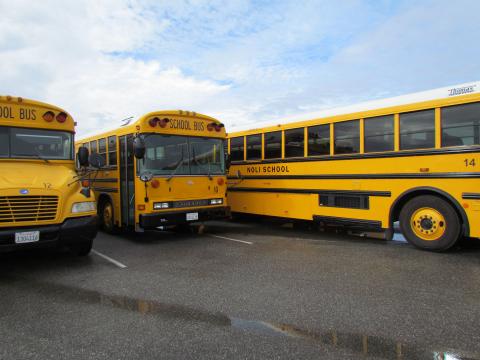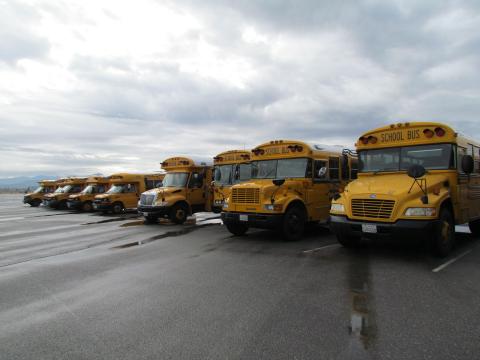Transportation is available for all Noli Indian School students ◆ By Mike Hiles
At a time when many school districts are cutting back on field trips and extending boundaries for school bus service, students at Noli Indian School on the Soboba Reservation are receiving door-to-door transportation. What makes this even more remarkable is that some of the students live more than an hour's drive away in cities like Carlsbad and Thermal.
Transportation Director Frederick Jones has been steering this department for more than three years and oversees all aspects of the 15 buses in the school's fleet as well as its 13 drivers.
"We serve any child within an 80-mile radius," Jones said. "Our drivers log about 1,500 miles per week."
He said his biggest challenges are adverse weather conditions and scheduling because not only do the children need to arrive on time for the morning bell, they also need to be taken home when school ends and/or after they have finished with sports or campus offered tutoring and enrichment. There are more than 120 students at the school in grades six through 12.
"I set up a four-directional system with one driver going each way, such as towards Riverside or up to the mountains, so every student can participate in after-school activities if they need to," Jones said. "We structure our runs in a certain way to cover all challenges such as a sick child needing to go home or a driver that calls off for an emergency."
Because the fleet is used for other purposes, it can be a challenge to make sure a vehicle is available when it is needed most. The same buses – and non-commercial vans – are regularly utilized for many Soboba related events.
"We are not just here for the school," Jones said. "We are centralized transportation and help with events for TANF, the Soboba Sports Complex and the Tribal Elders. If they need to go somewhere, we are here to take them."
Some of the school bus drivers head out as early as 2:30 or 3 a.m. to get all the students on their route picked up and brought to school on time.
Noli Principal Donovan Post said each driver is required to do a pre-trip checkout procedure every time they take a vehicle out. The safety inspection, which has the driver check out the bus from front to back, can take up to 30 minutes.
Fernando Gomez has worked at Noli for 15 years but has only been driving buses for the school the past couple of years. Being a campus supervisor and working with the Braves' football team before becoming a certified driver, he had been on several outings with the students but didn't realize what all that was entailed to become a driver.
Gomez starts his run at 4:30 a.m. and does his first pick-up in Riverside at 5:20 a.m. After he goes to half a dozen homes in that area he returns to the school and then drives around the Soboba Reservation to pick up another eight or nine students.
"I grew up in this valley and went to school with a lot of tribal members so I know some of these kids' parents and grandparents," said Gomez, 54. "I don't feel you have to tell me I'm doing a good job because when I get these kids to school and home again safely, that's my pride."
After fueling up the bus, he goes off the clock until 4 p.m. when he returns to take the later released kids home.
"I am a father and a stepfather and I want someone to transport my kids safely so that's why I take care to do the same with theirs," Gomez said. "Our whole crew does a very good job. I think we are like the offensive line on a football team who know their job is done well if the quarterback has the ball and the running back is running. When we get the kids to school and back home safely, we've done our job well."
Jones said the department's retention rate is pretty good compared to other companies he has worked for during more than 14 years he has spent in the industry.
"I've been a bus driver, a pre-trip trainer, a behind-the-wheel trainer, a supervisor and now director," said Jones, 60. "Seeing the industry from so many different perspectives has given me a unique advantage and helps me be a good liaison between management and drivers."
Jones said that California has the most stringent rules and regulations when it comes to safety. The department is audited annually to be sure drivers don't exceed the allotted hours and carry the proper licenses.
"The CHP (California Highway Patrol) has a very stringent licensing process, which is very different from other states," he said. "Our drivers need to complete 10 hours of in-service training each year and we do additional hours of mountain driving training and loading and unloading procedures when they start with us."
A DMV written test contains four parts and a total of 220 questions. After behind-the-wheel training the CHP will do a verbal test of all bus parts inside and out before taking potential professional drivers out for a driving test.
Jones said the CHP also requires a "student endorsement" for driving a school bus and because of all the extra precautions, California has less fatalities than any other state. He has regular meetings with a state monitor to keep abreast of changes and new laws, which constantly change.
"School buses in California are the safest form of transportation, which is good since they are carrying the most precious cargo: kids," Jones said.
Even during school breaks, the vehicles and drivers are kept busy. During Thanksgiving week, students are being taken to basketball practices.
"It takes a skilled person to be a school bus driver," Jones said. "Not only do they need to be a professional driver, but they need to be able to control children. They need to have patience, attentiveness, management skills and be caring and compassionate."




